Wisconsin's French Island faces stark choices as PFAS water crisis lingers
A lifeline could disappear due to a pollution lawsuit that has implications for the 1.7 million Wisconsinites who rely on private wells.
Wisconsin Watch
September 21, 2022 • West Central Region

Jessica Servais plays with her dog Allie on the Upper Black River Beach, locally known as "Airport Beach" in the town of Campbell on French Island on July 20, 2022. (Credit: Coburn Dukehart / Wisconsin Watch)

Jim Boisen and Margie Walker conceived of their single-story residence as a “forever home.”
They moved in 1979 to Wisconsin’s French Island, an unincorporated community of 4,300. Sandwiched between the Black and Mississippi rivers in the town of Campbell, it forms a picturesque piece of the Driftless Area where people toss tennis balls to their dogs at the beach and cordgrass rustles in the breeze. Visitors can catch water ski shows on Wednesday nights during the summer and grab battered haddock at Tom Sawyer’s Bar & Grill during lunch breaks.
When told her 2nd Avenue house is beautiful, Margie, 76, asks, “You wanna buy it?” She laughs, her face crinkling beneath wire-rimmed glasses.
Jim and Margie went antiquing throughout their 44-year marriage. They amassed a formidable collection of Delft Blue china, which they display in their cozy living room.
Margie started with thimbles, to which she added a menagerie of beer steins, windmills and clogs. The objects vary, but their imagery revolves around Dutch pastoral landscapes. Canals, levees and sailboats. Water everywhere.
But water is now their top worry.
Jim and Margie’s home connects to a private well that taps into French Island’s underground aquifer. Then they were told harmful chemicals had infiltrated it. Their house, sage green and surrounded by pink petunias, sits atop a toxic plume of PFAS that has disrupted life on the island.

Jim Boisen, 81, and Margie Walker, 76, live in the town of Campbell on French Island. The household is one of more than 1,350 on the island that has received free bottled water from the city of La Crosse and the state to replace drinking water contaminated by PFAS, the so-called forever chemicals. Photo taken July 20, 2022. (Credit: Coburn Dukehart / Wisconsin Watch)
PFAS, or per- and polyfluoroalkyl substances, are a class of more than 12,000 human-made compounds. The group of “forever chemicals” accumulate in the environment and human bodies over time. People primarily ingest the often odorless, colorless and tasteless substances through drinking water. PFAS are ubiquitous in consumer and industrial products, including certain firefighting foams.
Scientists haven’t studied most of the chemicals deeply, but they link two of the most widely researched, PFOA and PFOS, to a range of health problems including altered hormone levels, decreased birth weight, digestive inflammation and ulcers, high cholesterol, hypertension in pregnancy, kidney and testicular cancers and reduced vaccine effectiveness in children.
Manufacturers knew, and concealed, the hazards for decades.
Virtually no amount of PFAS are safe for consumption, according to the U.S. Environmental Protection Agency. In June, it updated its draft health advisories for PFOA and PFOS to miniscule levels — 0.004 parts per trillion and 0.02 ppt, respectively.
PFAS are manifesting in public drinking systems and surface waters across Wisconsin as testing increases. In 2020 and 2021, labs detected PFAS in nearly 98% of the 539 private drinking wells sampled in Campbell — contaminants that likely were present for years.
The Wisconsin Department of Natural Resources asks polluters to provide emergency bottled water to residents until the contaminants are mitigated or another solution is found. The agency provides water at state expense if no responsible party exists or the polluter is unwilling or unable to do so. Jim and Margie are among 1,350-plus French Island households who have received bottles through either the department or the city of La Crosse.
But those lifelines could disappear due to a pollution lawsuit that has implications for the 1.7 million Wisconsinites, roughly one-third of the state’s population, who rely on private wells.
An industry group sued the Department of Natural Resources in 2021, arguing that the agency can’t force polluters to clean up hazardous PFAS spills without first creating rules. The agency currently oversees the remediation of PFAS from at least 84 sites statewide, including French Island. But environmental rulemaking can take more than two years in Wisconsin due to bureaucratic hurdles Republican lawmakers enacted a decade ago.
The loss of government-provided water would leave residents with stark choices: depart their homes, pay thousands of dollars for their own jugs or knowingly consume toxic chemicals.
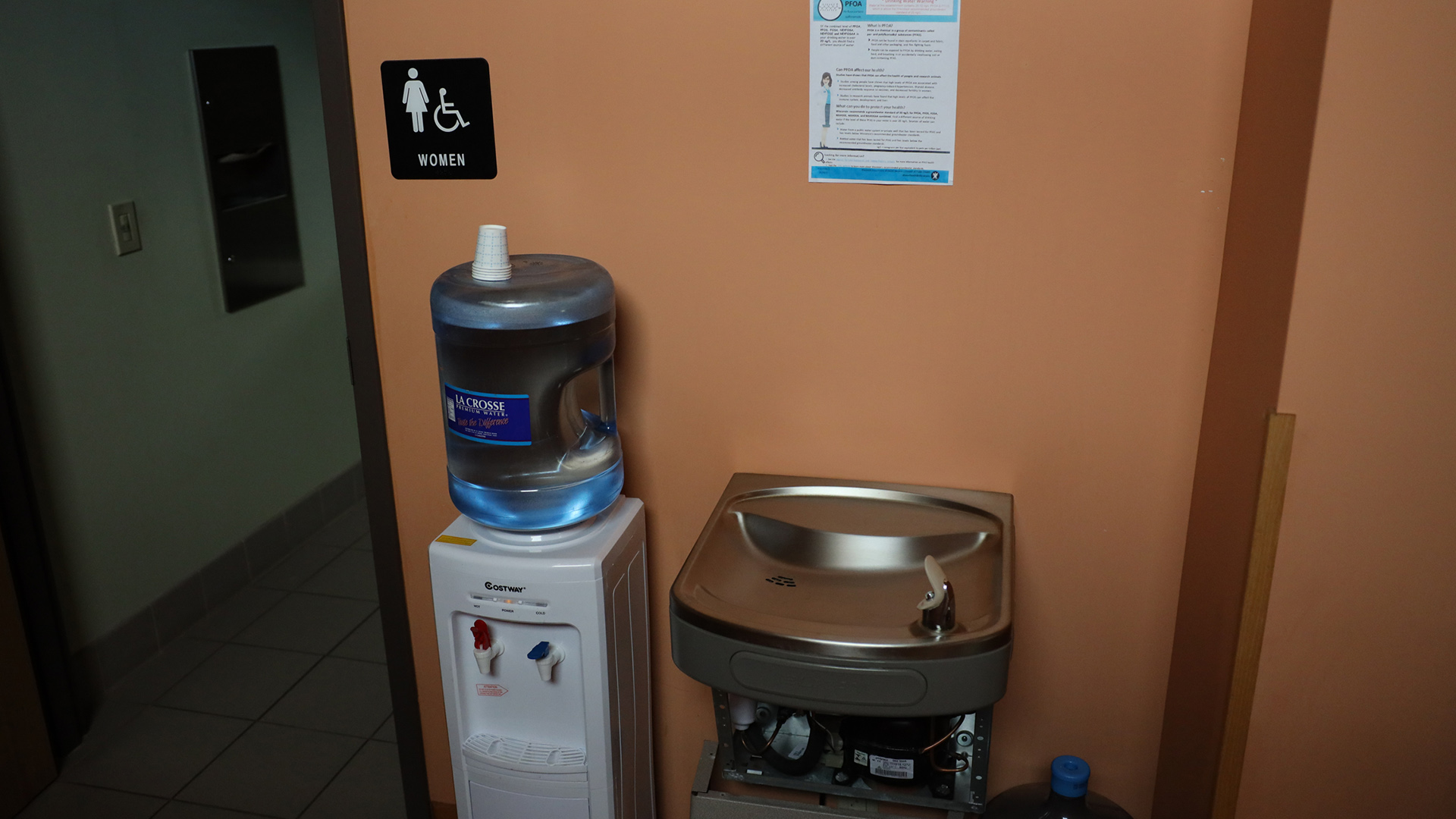
A flier at the F.J. Robers Library in the town of Campbell, outside of La Crosse, warns people of the dangers of PFAS chemicals in the drinking water. The sign hangs above a drinking fountain on July 20, 2022, disconnected due to high levels of PFAS. The library provided bottled drinking water instead. (Credit: Coburn Dukehart / Wisconsin Watch)
Meanwhile, the city of La Crosse — due east of French Island — has annexation rights to certain Campbell properties whose owners use city water instead of private wells. The agreement is part of a decades-long boundary feud between the municipalities. The township wants to modify it out of concern that annexation will chip away at Campbell’s property tax revenue, increase residents’ tax bills and jeopardize the island’s autonomous fire and police services.
Those controversies put French Island at the nexus of legal wrangling over how governments assign fault and assist PFAS-polluted communities.
“In many ways, it feels like we are being held hostage,” Campbell Supervisor Lee Donahue said.
Crash and burn
On June 16, 2001 — a sunny, clear morning — a 1950s-era two-seater jet smashed into the ground during an airshow at the La Crosse Regional Airport.
The aircraft’s wing tip tank separated in flight and destroyed the plane’s tail. Fire consumed the deformed fuselage, leaving the grass charred, just blocks away from Jim and Margie’s home.
“I didn’t want to look and see it burn knowing that there were two people inside it,” said Jim, 81.
PFAS presumably sunk into the ground from the firefighting foam used to extinguish the burning wreckage.
The concussion reverberates years later. That’s what Jim and Margie learned when a city contractor tested their well in November 2020.
It contained PFOA and PFOS in the amount of 70 ppt along with a cocktail of 10 other PFAS. The total concentration was 12.5 times greater than that which the Wisconsin Department of Health Services considers hazardous.
A contractor hired by La Crosse in 2019 documented several other PFAS hotspots beneath the airport. Spills occurred on the terminal apron and possibly at the airport’s former fire station. Staff also annually collected foam samples from firefighting equipment west of the airport taxiway, as the Federal Aviation Administration required. The agency mandates that airport firefighting foam meet performance standards. Currently, only PFAS-containing foams do.

The La Crosse Regional Airport on French Island is the source of PFAS that contaminates the community’s drinking water. The “forever chemicals” likely come from firefighting foam used at the airport. PFAS were first detected in a municipal well in 2014 and in private wells in 2020. More than 1,350 island households have received free bottled water from the city of La Crosse and the Wisconsin Department of Natural Resources. Photo taken July 20, 2022. (Credit: Coburn Dukehart / Wisconsin Watch)
During the 1970s through 1988, the La Crosse Fire Department and airport personnel also participated in staged burns. They ignited industrial waste solvents in pits and practiced extinguishing the flames using PFAS-containing foam.
“I was told by our personnel when I started in the fire department and would train that product was the same thing as dish soap — that it was OK,” said retired firefighter Mike Jorgenson, 66. “It covers the fire with a blanket just like soap suds when you spray it.”
The La Crosse airport no longer uses the foam during practice drills. Wisconsin lawmakers limited its use in 2020 to emergencies or equipment tests inside facilities with special containment and disposal protocols.
The Department of Natural Resources asked the city to provide bottled water to residents whose wells exceed state health recommendations. But the city could not handle the prolific contamination alone. City and county officials requested assistance, prompting the Department of Health Services to issue an island-wide drinking water advisory in March 2021. That made all French Island residents eligible for temporary emergency water.
Death by 1,000 concessions
Jim and Margie used to live simple lives, relishing each visit with their 17 grandkids.
Now each month, Culligan workers stuff a half-dozen jugs of water into their coat closet. Each weighs 40 pounds, and Jim has to roll them on the floor to attach them to their dispenser.
Jim and Margie received their first bottles on Dec. 24, 2020.
“That was our Christmas present,” said Jim.
When he wants a glass of water, he catches himself gliding toward the sink. He stops. Then reroutes to the Culligan machine.
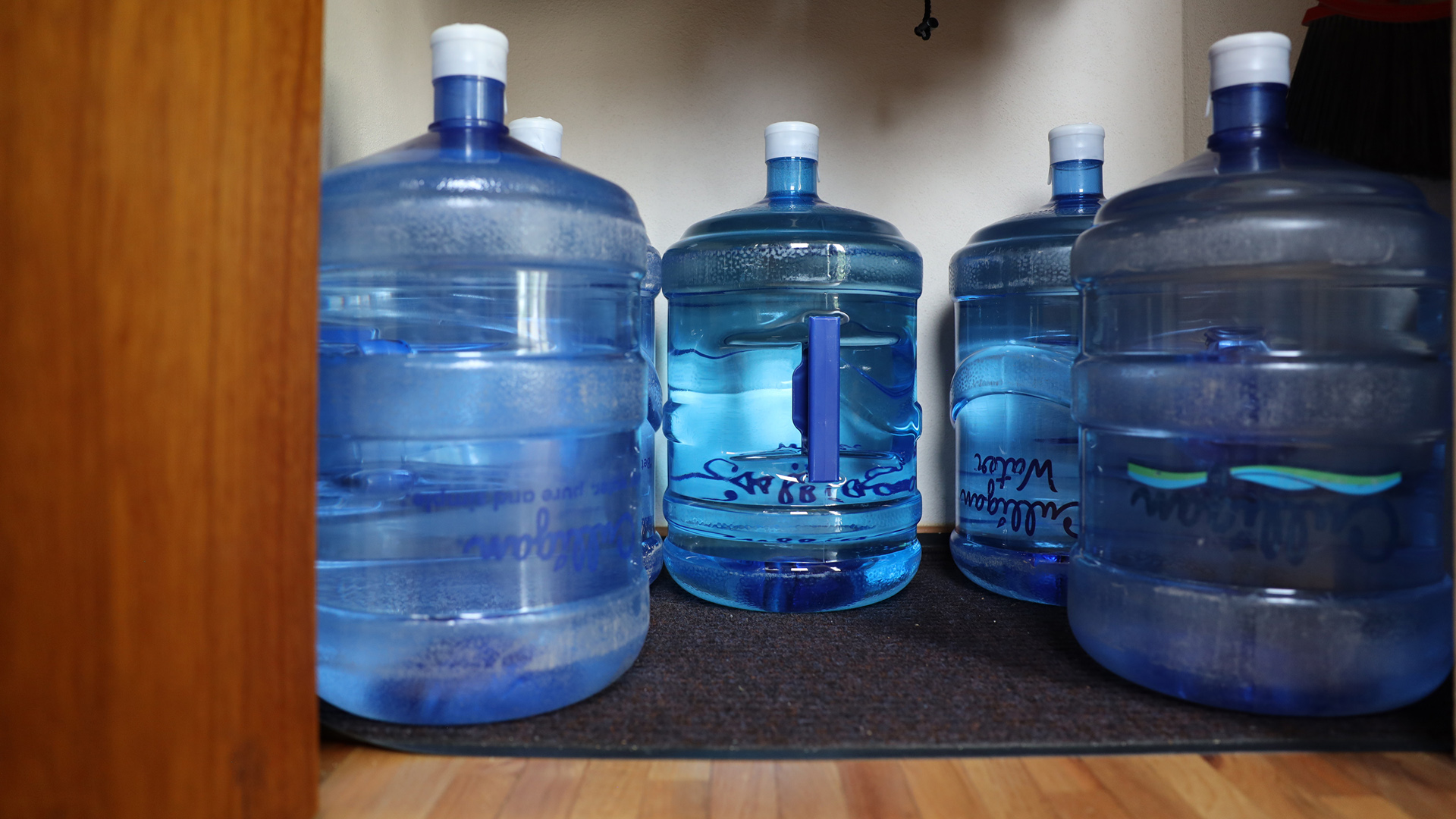
Jim Boisen, 81, and Margie Walker, 76, store 5-gallon jugs of water in their home in the town of Campbell. Boisen and Walker, who live on French Island in the Mississippi River, worry that if they had to pay for the water themselves, they wouldn’t be able to afford it. The water is provided by the city of La Crosse and the state of Wisconsin to replace drinking water contaminated with PFAS. Photo taken July 20, 2022. (Credit: Coburn Dukehart / Wisconsin Watch)
Without clean water, residents rethink their routine decisions, once performed reflexively. They forget that their taps are polluted, errantly rinsing their toothbrushes under the faucet, gargling in the shower or giving their tomatoes a drink with the garden hose.
Then they remember: They must give up these things for their health’s sake. Death by 1,000 concessions.
French Islanders recall the friends and family who developed cancer and wonder whether PFAS were to blame. Their questions go unanswered. One of the more insidious aspects of living on a contaminated island is the veil of uncertainty.
Jim noticed a lump on his neck about two years after moving to French Island. Doctors removed the growth, which was attached to his thyroid. It returned this year, and Jim remains under observation for cancer.
Losing their emergency water would amplify the couple’s burdens.
The cost would be “huge,” said Margie, a retired Gundersen Health System employee. Jim, a former truck driver and U.S. Marine Corps veteran, said they barely make their tax payments and fear losing their house. The nagging fret wears on them during their retirement.
“This ‘golden years’ is a bunch of shit,” Jim said, his voice cracking. “This has knocked our golden years right down the tubes.”
Spills law targeted
Wisconsin Gov. Tony Evers wearily delivered his speech during a July press conference inside French Island’s public library. Behind him hung a poster of a dinosaur, encouraging kids to “read beyond the beaten path.”
The Democrat announced the state would sue the 3M Company, DuPont and other manufacturers of PFAS-containing materials. He described emergency bottled water as a Band-Aid, not a solution.

Gov. Tony Evers speaks at a press conference at the F.J. Robers Library in the town of Campbell outside of La Crosse on July 20, 2022. Evers appeared with Wisconsin Attorney General Josh Kaul to announce that the state filed a lawsuit against PFAS manufacturers they allege knew about the harmful impacts of the “forever chemicals” yet failed to share that information with the public. (Credit: Coburn Dukehart / Wisconsin Watch)
A separate legal challenge from Wisconsin Manufacturers and Commerce, the state’s largest business lobby, threatens to rip the bandage off before residents have found an alternative.
That lawsuit, filed in Waukesha County Circuit Court, stems from a pollution case on the other side of Wisconsin. WMC sued the Department of Natural Resources last year on behalf of an Oconomowoc dry cleaning business after the agency directed the owners to address spilled PFAS on the property.
The plaintiffs’ attorneys argue that the department cannot enforce the order on a substance that has not been subject to rulemaking. The up to 30-month process would entail adopting a list of substances and thresholds that make them hazardous — all subject to legislative approval.
Without knowing how the department defines a hazardous substance, WMC called it “impossible for a party to know when they are required to report” a spill. The agency “essentially expect(s) the public to read their minds,” WMC claimed.
The Department of Natural Resources maintains that a court loss would strip its authority to compel polluters to clean up chemicals and provide emergency water under the state’s long-standing spills law. The statute requires the reporting of spills and environmental restoration by entities that pollute air, soil or water or that discover past contamination on their property.
Several French Island families filed affidavits in the case, describing economic hardships they would face if they lost their bottled water. Some residents wondered what it would mean to leave the island, yet lament the uncertain financial prospects of selling their homes.
“How do you sell a house that’s got a bad well?” said Linda Pralle, 63, a property owner whose water tested at 424 ppt for PFOA and PFOS.

A small airplane flies over Upper Black River Beach, locally known as “Airport Beach” in the town of Campbell on French Island on July 20, 2022. The beach is located next to the La Crosse Regional Airport and near municipal wells No. 23 and No. 24, which were found to be contaminated with PFAS, likely due to the use of firefighting foam at the airport. The La Crosse Water Utility removed the wells from production. (Credit: Coburn Dukehart / Wisconsin Watch)
In April, a judge sided with industry groups but later delayed the effect of his order while the state agency appeals. The case holds repercussions for the department’s authority to respond to all emerging contaminants, especially PFAS.
The Department of Natural Resources has declined to comment during the litigation. WMC did not respond to requests for comment.
Legal experts call the spills law versatile because it relies upon broad criteria to define hazardous substances, such as concentration, quantity and toxicity.
“It is meant to err on the side of caution and allow the DNR to react,” said Rob Lee, staff attorney with Midwest Environmental Advocates, which has filed a brief in defense of the spills law. “There is no way that DNR can anticipate any and every discharge that might have some adverse impact on public health and the environment.”
That contrasts with other states and the federal government, which allow for both the listing of hazardous compounds individually and the designation of hazardous substances through other criteria, said Steph Tai, a University of Wisconsin-Madison law professor.
But regulation of PFAS is difficult given the thousands of such chemicals in existence.
Legislative doldrums
Shortly after Evers finished his French Island speech, Donahue, the Campbell supervisor, stood before a pack of reporters, fuming, taking aim at state legislators and business groups who have resisted efforts to regulate the chemicals.
A June Marquette Law School poll found that 61% of Wisconsinites were concerned about PFAS.
“It is beyond me,” Donahue said, “how any legislator who’s ever had a family, been a part of a family, can say, ‘I’m not concerned about the health of others.'”
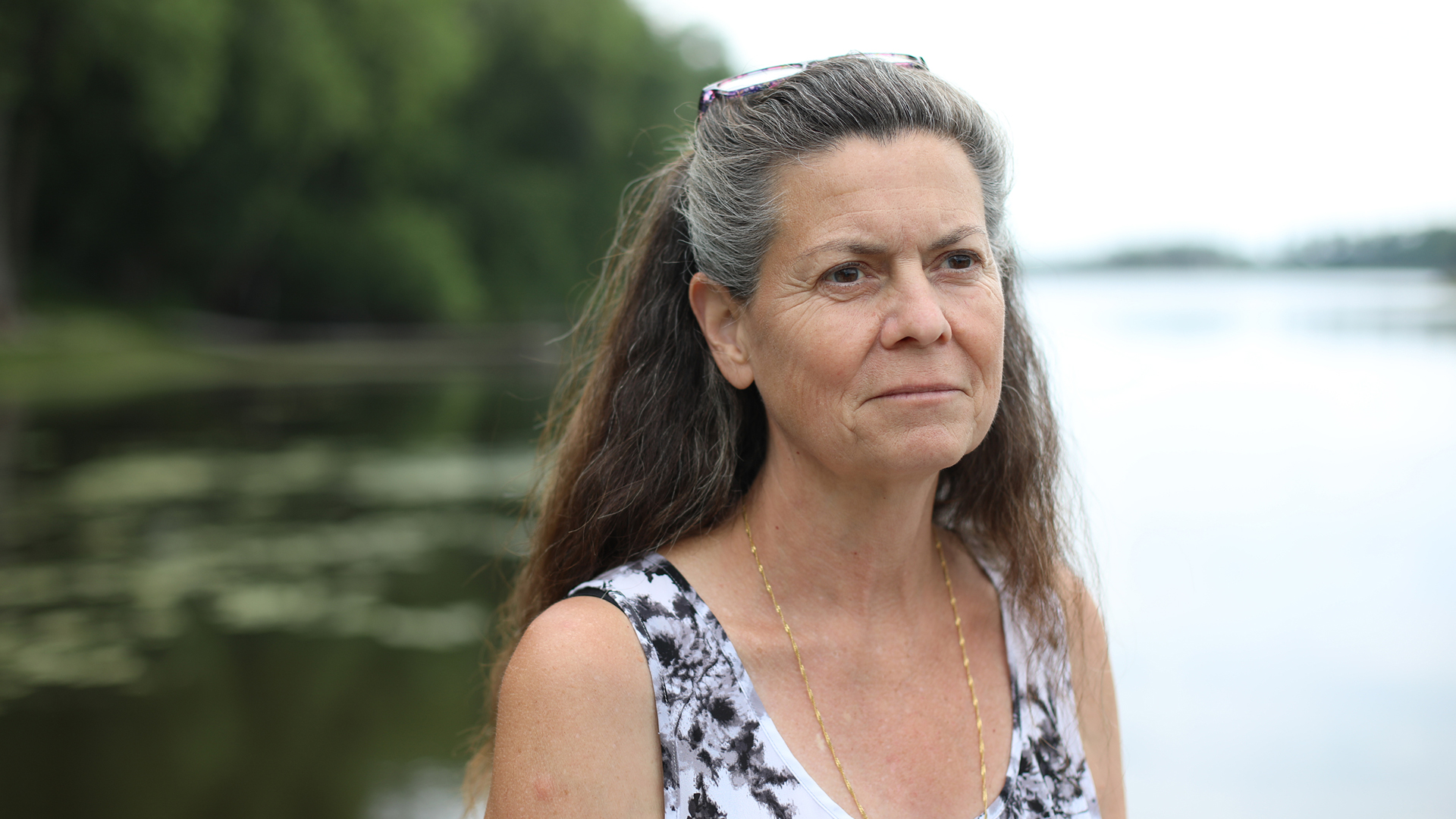
Lee Donahue lives near the Mississippi River on Wisconsin’s French Island. Donahue is a supervisor for the town of Campbell who is drawing attention to PFAS contamination on French Island. Her household is among more than 1,350 on the island that have received free bottled water from the city of La Crosse and the state. Photo taken July 20, 2022. (Credit: Coburn Dukehart / Wisconsin Watch)
Democratic lawmakers introduced bills in 2019 and 2021 that would have required the Department of Natural Resources to establish PFAS standards and reporting requirements or to apply the Department of Health Services’ recommended enforcement standards and offer well-testing grants. But neither bill received hearings in GOP-controlled committees. The Legislature also stripped measures from Evers’ budget that would have helped fund the state’s PFAS Action Plan.
Donahue, a French Island resident since 2005, lives near its western side by Lake Onalaska. In the nearby backwaters adjacent to the dike that borders Lock and Dam No. 7, beavers feed their young and thwack their tails on summer evenings. Boats ply the waters. And in the winter, people come to skate and ice fish. Life on French Island is ideal, Donahue says, except for its drinking water.
“Our Legislature has the ability to make decisions that will increase the health and safety of our residents in Campbell, in Peshtigo, in Rhinelander, Wausau,” she told the news crews. Her hands rose and fell with each mention of a Wisconsin municipality grappling with PFAS contamination.
“And the longer that they fail to do so,” she trailed off, shaking her head.
“I don’t know how you sleep at night.”
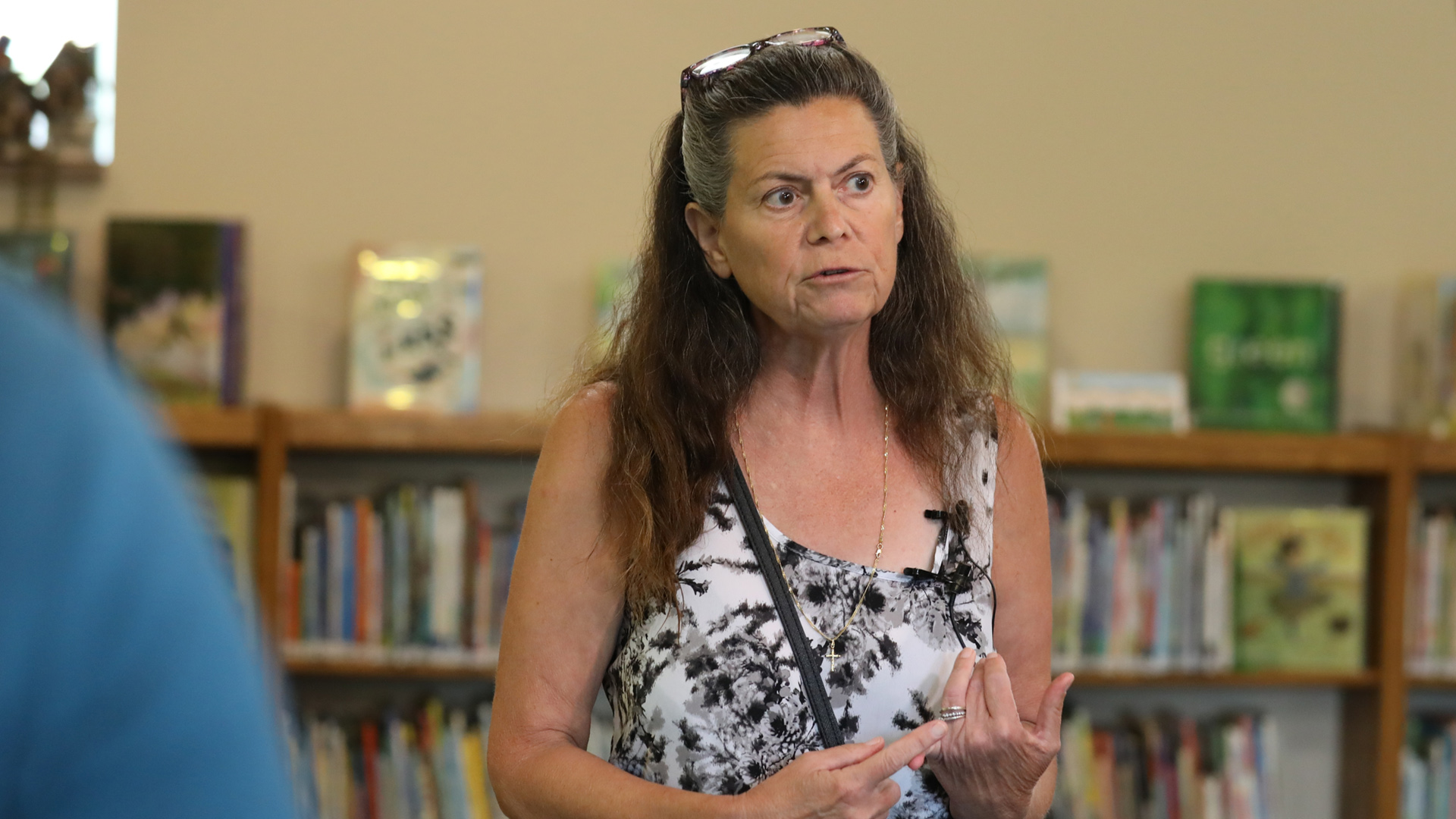
Town of Campbell supervisor Lee Donahue speaks after a press conference at the F.J. Robers Library in the town of Campbell outside of La Crosse on July 20, 2022. (Credit: Coburn Dukehart / Wisconsin Watch)
The office of GOP Senate President Chris Kapenga declined several requests for an interview to respond to criticism and discuss his caucus’ plans to mitigate PFAS. Assembly Speaker Robin Vos and Senate Majority Leader Devin LeMahieu’s offices did not respond to requests for comment.
Republicans, like their Democratic colleagues, have offered some PFAS-related proposals in recent legislative sessions. Rep. Elijah Behnke of Oconto introduced a bill in 2021 to appropriate $10 million for testing and remediation. However, residents of PFAS-polluted communities and environmentalists criticized a caveat in the legislation: that municipalities receiving the funding could not sue those responsible for the contamination.
In August, Green Bay Sen. Eric Wimberger released a bill package that focuses on the spreading of PFAS-laden waste on farmland.
Roadblocks to regulation
As the spills law challenge plays out in court, critics say the GOP-appointed majority on the Wisconsin Natural Resources Board, which sets Department of Natural Resources policy, has also thwarted the agency’s efforts to regulate PFAS.
That majority holds, in part, because Fred Prehn, an appointee of former Republican Gov. Scott Walker, refused to leave the board after his term expired in May 2021. Wisconsin’s conservative-majority Supreme Court ruled that he could do so until the Senate confirms Evers’ nominee; the chamber has yet to hold a hearing. Prehn, who did not respond to a request for comment, cast the deciding vote in contentious decisions on PFAS.
In February, the board rejected PFAS groundwater quality standards and approved less stringent regulations for PFAS in drinking water. It approved standards as proposed for surface water.
Greenlighting PFOA and PFOS groundwater standards would not expand the department’s authority to order a spill cleanup, but it does clarify the process. Standards better inform polluters of remediation goals. Without them, the agency and responsible party must develop a standard for each spills site, according to the Department of Natural Resources.
Natural Resources Board Chairperson Greg Kazmierski said in an interview that the lack of cost-effective options to remove PFAS from water influenced his vote against the department’s groundwater proposal. He and other board members criticized a Department of Natural Resources estimate that posited that businesses and governments would incur expenses totaling $9.5 million over two years — just short of the $10 million threshold that requires legislation to authorize the change.
“Our perspective all along has been that these are very serious chemicals and that we need to try to do something about it,” Kazmierski told Wisconsin Watch. “However, that being said, is it even doable?”
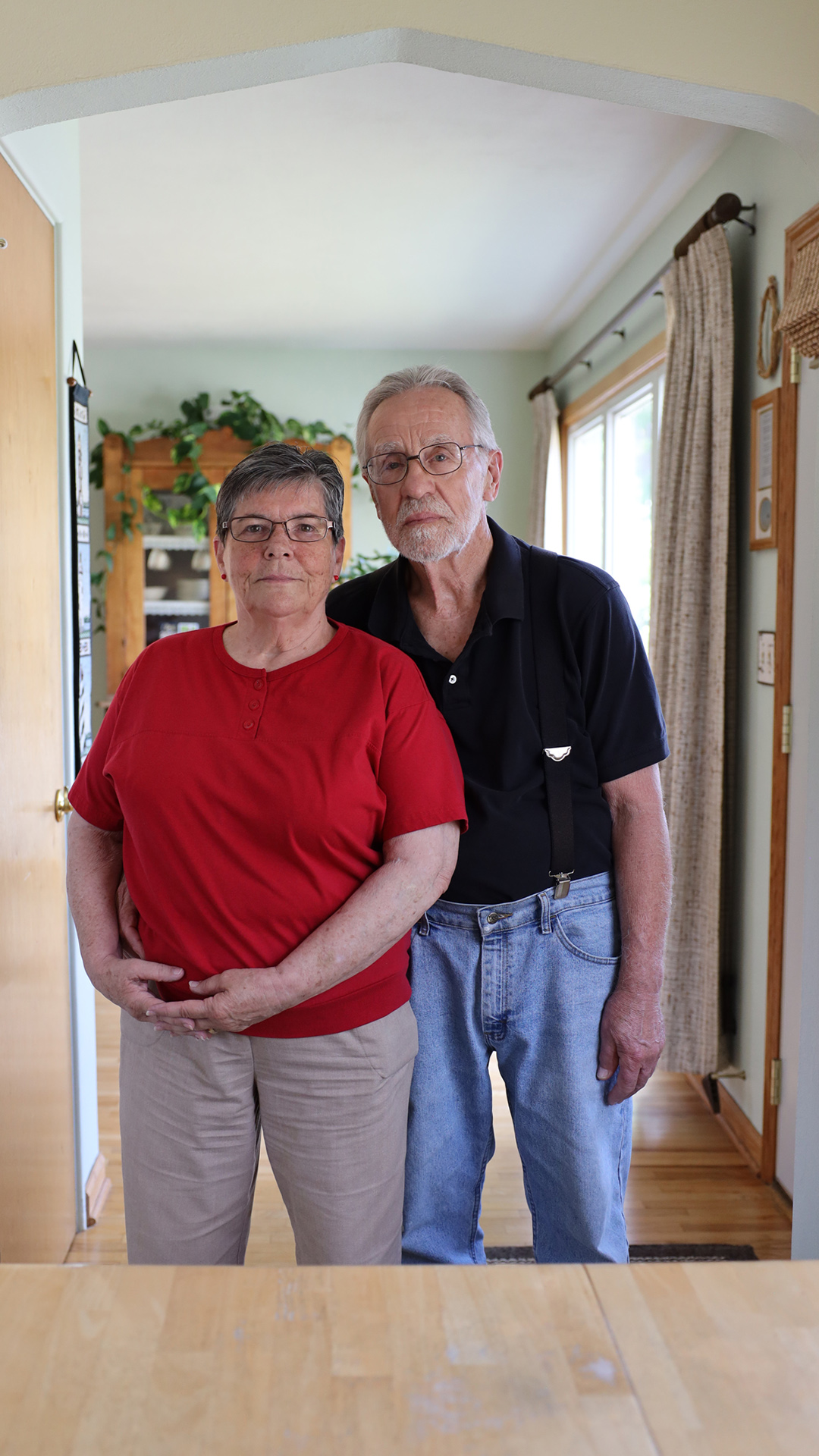
Jim Boisen, 81, and Margie Walker, 76, found out in 2020 that their drinking water was contaminated, so they threw out a vast quantity of frozen soup that Boisen had made. The couple, who are on a limited income, say having to throw out homemade food was a financial and emotional blow. They are seen at their home in the town of Campbell on French Island in the Mississippi River near La Crosse on July 20, 2022. (Credit: Coburn Dukehart / Wisconsin Watch)
The EPA’s updated health advisories for PFOA and PFOS implied that almost no amount of the chemicals is safe to consume over a lifetime. The levels were far lower than the standards the Department of Natural Resources proposed in 2019 for both groundwater and public drinking water: 20 ppt for PFOA and PFOS individually or combined.
Vice Chairman Bill Bruins downplayed the significance of the EPA’s draft advisory when asked whether he would support tightening Wisconsin’s standards.
Regulatory bodies must ensure their rules are “right and just,” he said, and health advisories should be “properly vetted” before the state acts upon them.
“If we try to eliminate all the hazards in our daily living, we tend to create a bigger and bigger bubble and pretty soon we really aren’t living,” Bruins told Wisconsin Watch. “The PFAS chemicals have been around a long time and been used for some very beneficial things for a long time. And whatever we do, whatever we implement, as we understand those chemicals, they aren’t going to disappear overnight.”
The Department of Natural Resources in September restarted the process to set groundwater standards for several PFAS, including the two rejected by the Natural Resources Board.
French Island residents find some hope for federal-level action. The EPA in August proposed designating PFOA and PFOS as hazardous substances, which would require polluters to report spills and potentially pay for the cleanup. The Department of Natural Resources is assessing what that change means for Wisconsin.
Additionally, the EPA expects to issue enforceable drinking water standards in 2023 for four types of PFAS in public water systems. Wisconsin would have to write a new standard to comply unless the state enacts tighter regulations first. The federal rule would not apply to private wells because the EPA does not regulate them.
French Island residents on private wells would still fall through the cracks.
Delayed warnings
Campbell Clerk and Treasurer Cassandra Hanan recalls the October 2020 day when then-La Crosse Mayor Tim Kabat called to say that PFAS were discovered on airport property.
The city first detected the chemicals in a French Island well as early as 2014. From June 2017 through April 2019, utility staff attempted to flush PFAS from the well. Under a Department of Natural Resources permit, they intermittently pumped PFOA- and PFOS-laden water — with some concentrations as high as 210 ppt — into the Black River, according to records reviewed by Wisconsin Watch. That was before the state issued any health advisories for PFAS.
Then-La Crosse Utilities Manager Bernie Lenz told French Island residents in 2021 that PFAS levels in the discharged water barely exceeded the Department of Health Services’ advisory level of 20 ppt and was essentially drinkable. City records contradict that claim. Lenz, who left his post this spring, could not be reached for comment.
Testing in 2018 and 2019 detected PFAS in a second island well. Staff shut off both wells as a precaution before the Department of Natural Resources determined that the airport contamination posed a threat and ordered further investigation.
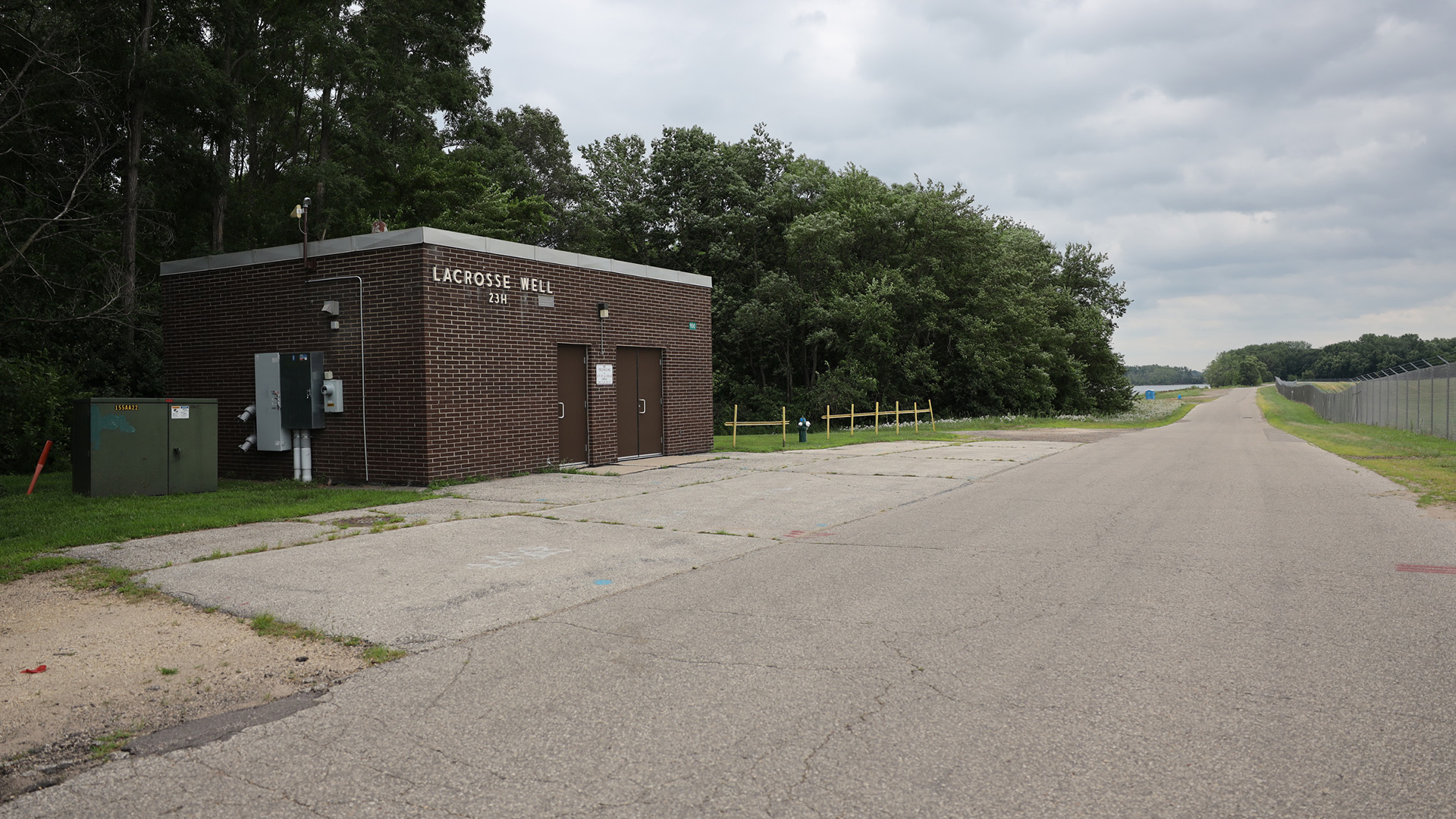
Municipal Well No. 23 in La Crosse is across the street from the La Crosse Regional Airport in the town of Campbell on French Island adjacent to the Mississippi River. Firefighting foam used at the airport has likely contaminated municipal and private wells in the area. The La Crosse Water Utility has removed the well from production. Photo taken July 20, 2022. (Credit: Coburn Dukehart / Wisconsin Watch)
City officials did not publicly notify island residents for an additional 17 months — after testing confirmed that PFAS had possibly reached private wells.
“They left us continuing to drink that water for years,” said third-generation island resident Amanda Hartley, 38, whose family’s well water measured 4.8 ppt for PFOA and PFOS and nearly double the public health standard for a third PFAS known as PFHxS.
“You just have to wonder, did you poison your family?”
Residents asked city representatives to explain the delay during an October 2020 public information session. John Storlie, a consultant from The OS Group, a city-contracted environmental compliance firm, said officials initially believed that PFAS existed only near the practice burn pits.
“The knowledge about these chemicals is evolving very quickly,” he said. “We really did not expect to find testable levels across the airport as we have.”
When reached by telephone, Storlie said he was not authorized to speak to Wisconsin Watch.
La Crosse Mayor Mitch Reynolds took office in April 2021 — three months after he called the situation in Campbell potentially “disastrous” for the city.
“I feel like you have a responsibility to fix the messes that you make,” he told viewers during an online forum. “If the city of La Crosse is in a position where it’s made a phenomenal mess — unwittingly, to be clear — through this PFAS contamination, they better do something about it.”
Reynolds did not answer emailed questions from Wisconsin Watch. Instead, he summarized the city’s efforts to address the chemicals. Those included securing $3.73 million in federal spending to treat city wells for contamination, offering to immediately connect impacted French Island neighborhoods to city water and negotiating a new water supply agreement with Campbell.
Campbell officials delivered a draft water agreement to La Crosse in March 2022 that would take annexation off the table, but the city has yet to respond. Reynolds told them during an August meeting that negotiating a new agreement was not a high city priority, Campbell’s attorney said. As for the offer to connect PFAS-affected properties to city water, that service was contingent upon annexation.
The city tested wells south and west of the airport throughout its investigation. Additional sampling later conducted by the DNR revealed widespread contamination throughout French Island, including areas north and west of the airport for which city officials disavowed responsibility.
At least 787 French Island residents have filed notices of claim against La Crosse — precursors to lawsuits or legal settlements. The number is now “significantly higher,” said Tim Jacobson, an attorney representing the claimants. For their part, the city and a collection of island residents sued 23 PFAS manufacturers, including 3M and Tyco Fire Products. Those cases were combined with others nationwide in a lawsuit being heard in a South Carolina federal court.
A 3M spokesperson said in a statement that the company “acted responsibly in connection with its manufacture and sale of PFAS” and “will vigorously defend its record of environmental stewardship.” A Tyco spokesperson declined to comment on the ongoing litigation.
Avoiding ‘bad water’
Not all island residents — that is, young children — fully understand their predicament.
The Brice family, who has lived in their French Island home since 2006, did not test their well. They assume PFAS seeped into it as it did with their neighbors’.
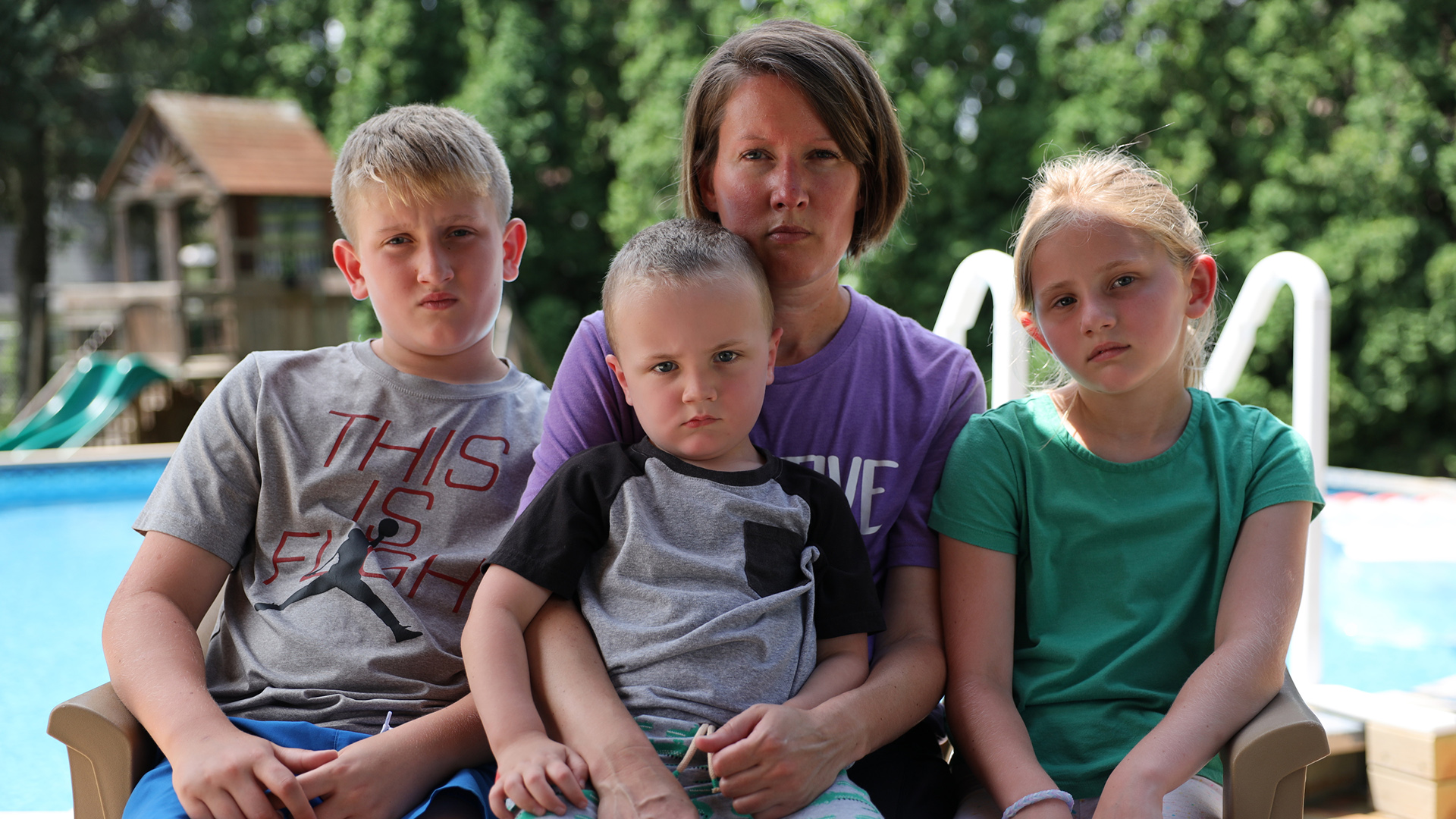
Heather Brice is pictured with her children, from left, Jameson, 11, Jackson, 4, and Ava, 9, at their home in the town of Campbell on French Island near La Crosse on July 21, 2022. They haven’t tested their water for PFAS because it’s expensive and they assume it’s contaminated like the wells of their neighbors. They used to have an extensive garden with pumpkins, peas, cucumbers and tomatoes, but they no longer grow produce anymore because of PFAS concerns. (Credit: Coburn Dukehart / Wisconsin Watch)
The Brices and their pug-beagle mix, Coco, drink water from a black Culligan dispenser. The backyard, once bursting with vegetables, has been winnowed to hydrangeas and lilies.
Heather Brice, 43, and her older son and daughter, Jameson, 11, and Ava, 9, do their best to explain to their younger brother why he cannot drink the “bad water.”
“My baby brother does not know what to do because he is only 3 years old and we use the water every day,” Ava once wrote in an essay. “It is so hard to keep my baby brother from doing things that are bad.”
Jackson, now 4, is apt to swallow the water in their outdoor pool or put his hands in his mouth after playing with the bathroom faucet.
Heather worries. How will the contamination affect her kids?
“So, I don’t know,” she said. “It’s frustrating.”
Jim Boisen also lacks answers. Who will pay, in the end?
“I’m not the type of person who is looking for a million-dollar settlement or something, but I want some satisfaction,” he said. “My wife, my kids, my grandkids — I won’t be around long enough probably to see what happens to them as a result of this. But until the day I die, I’ll be thinking about it.”
He and Margie planned to stay in their home until someone carried them to a nursing facility. They would have to sift through their possessions and pick only the best things to take. They wouldn’t be able to bring all of Margie’s china. Instead, she seeks a buyer.
Maybe then, Margie thinks, they can keep the collection whole.
Bennet Goldstein covers water quality and other environmental issues for Wisconsin Watch and the Mississippi River Basin Ag & Water Desk, a consortium of 10 news organizations. He is a corps member with Report for America, a national service program that places journalists into local newsrooms. The nonprofit Wisconsin Watch collaborates with WPR, PBS Wisconsin, other news media and the University of Wisconsin-Madison School of Journalism and Mass Communication. All works created, published, posted or disseminated by Wisconsin Watch do not necessarily reflect the views or opinions of UW-Madison or any of its affiliates.
 Passport
Passport




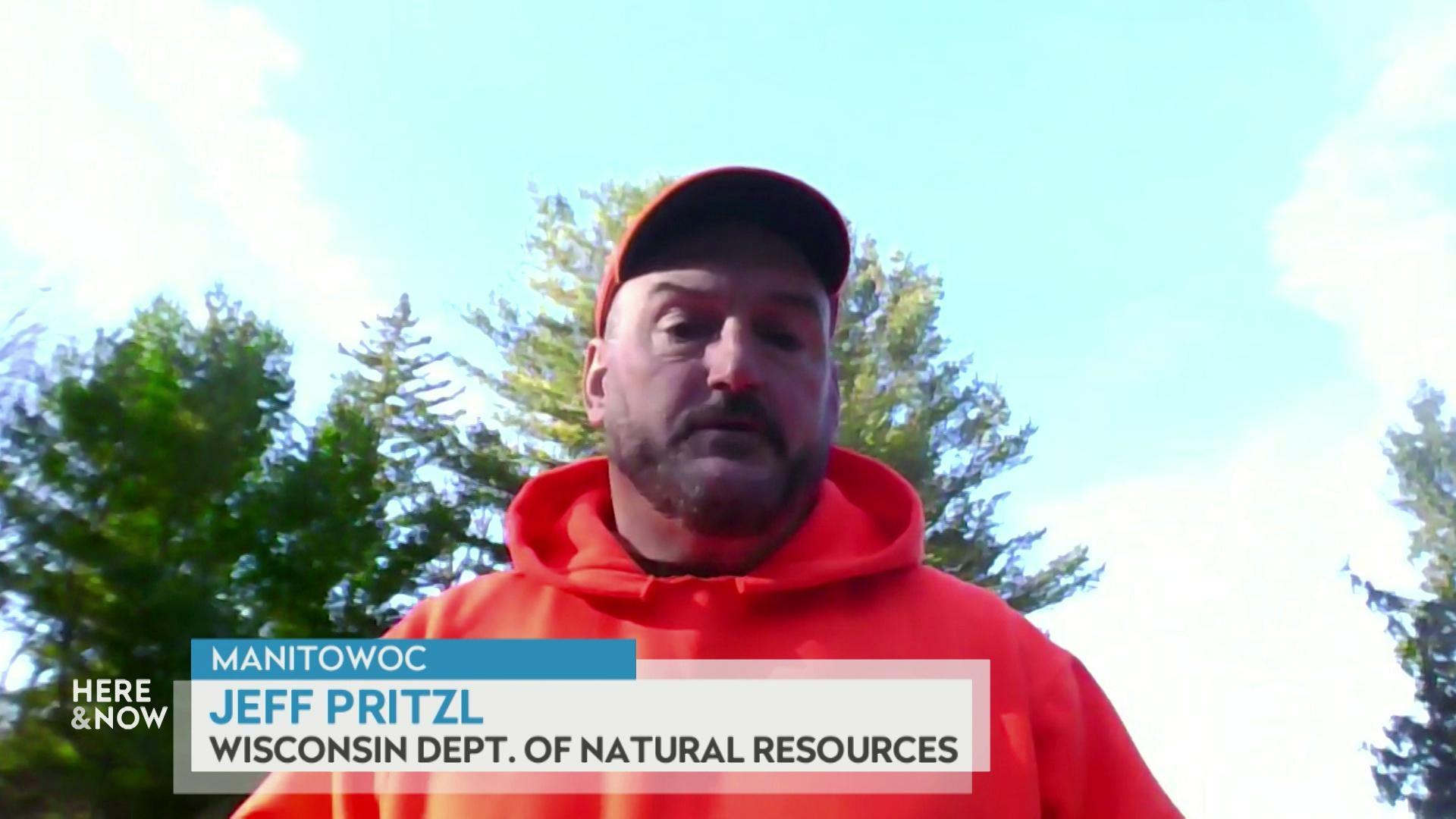
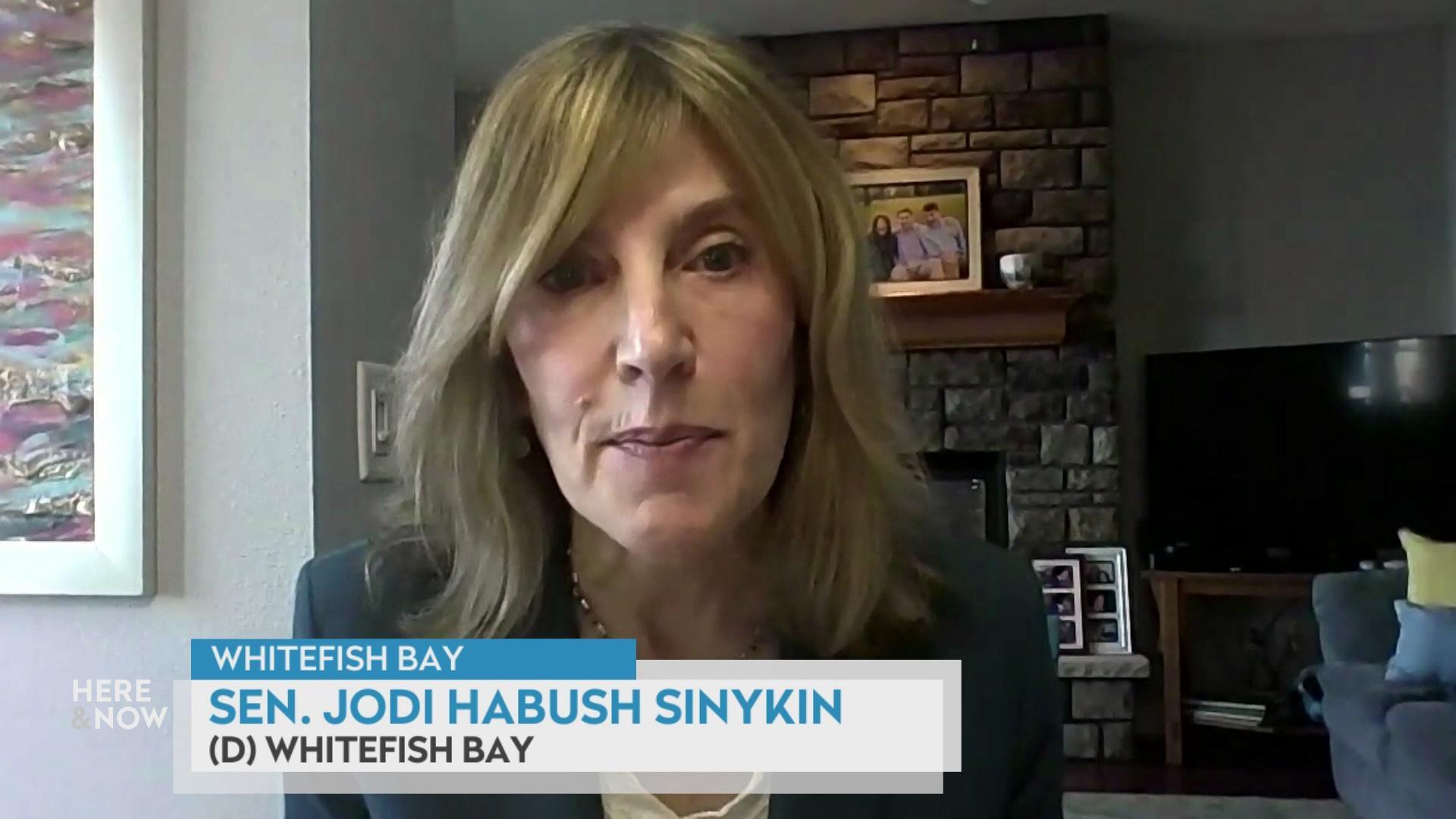

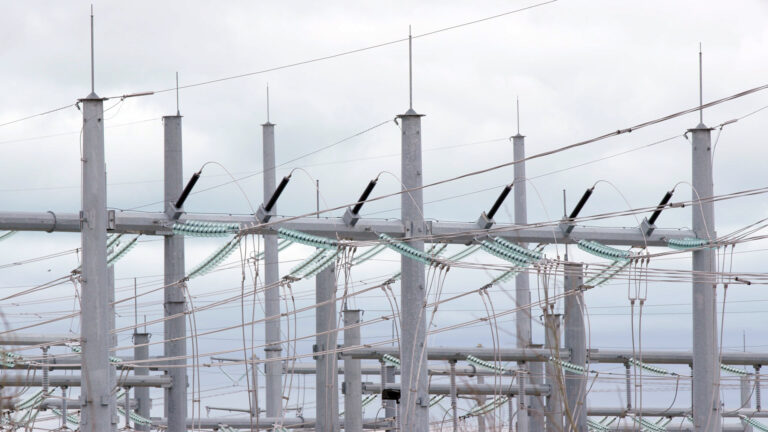
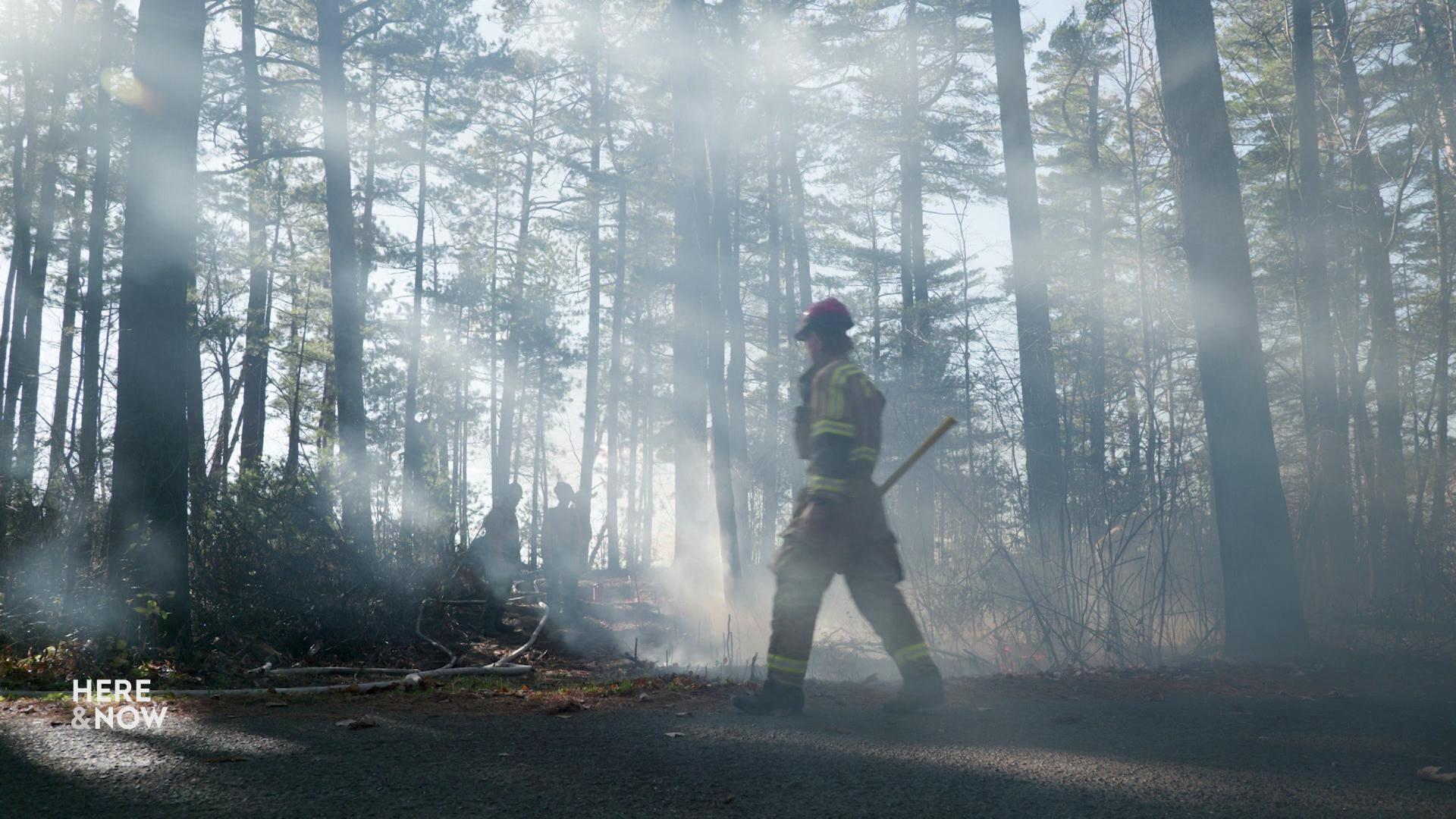


Follow Us